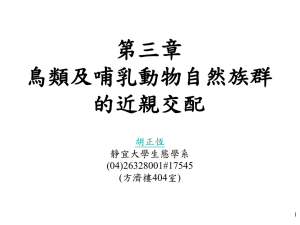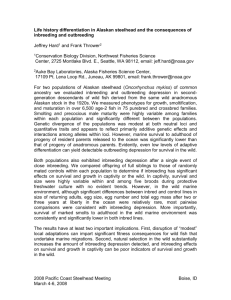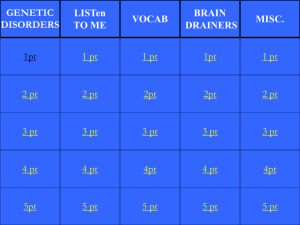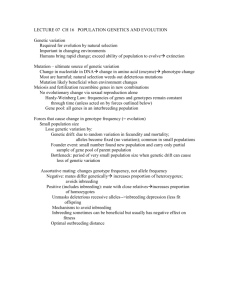When we revegetate or restore an area rather than allow
advertisement
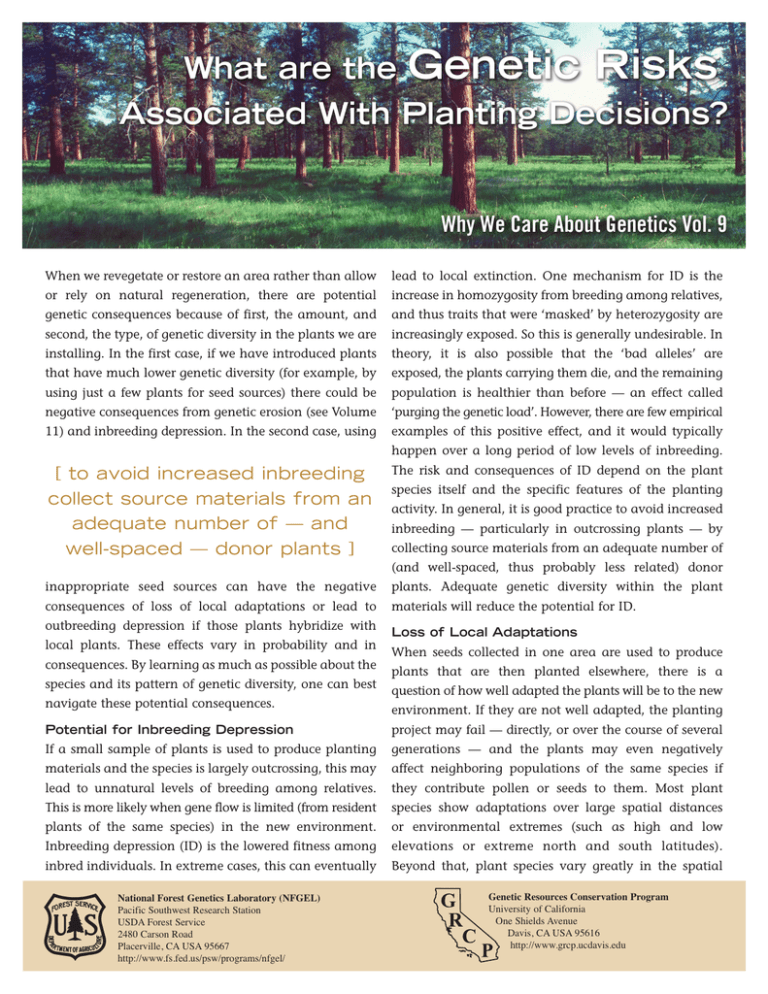
When we revegetate or restore an area rather than allow lead to local extinction. One mechanism for ID is the or rely on natural regeneration, there are potential increase in homozygosity from breeding among relatives, genetic consequences because of first, the amount, and and thus traits that were ‘masked’ by heterozygosity are second, the type, of genetic diversity in the plants we are increasingly exposed. So this is generally undesirable. In installing. In the first case, if we have introduced plants theory, it is also possible that the ‘bad alleles’ are that have much lower genetic diversity (for example, by exposed, the plants carrying them die, and the remaining using just a few plants for seed sources) there could be population is healthier than before — an effect called negative consequences from genetic erosion (see Volume ‘purging the genetic load’. However, there are few empirical 11) and inbreeding depression. In the second case, using examples of this positive effect, and it would typically happen over a long period of low levels of inbreeding. [ to avoid increased inbreeding collect source materials from an adequate number of — and well-spaced — donor plants ] The risk and consequences of ID depend on the plant species itself and the specific features of the planting activity. In general, it is good practice to avoid increased inbreeding — particularly in outcrossing plants — by collecting source materials from an adequate number of (and well-spaced, thus probably less related) donor inappropriate seed sources can have the negative plants. Adequate genetic diversity within the plant consequences of loss of local adaptations or lead to materials will reduce the potential for ID. outbreeding depression if those plants hybridize with Loss of Local Adaptations local plants. These effects vary in probability and in consequences. By learning as much as possible about the species and its pattern of genetic diversity, one can best navigate these potential consequences. When seeds collected in one area are used to produce plants that are then planted elsewhere, there is a question of how well adapted the plants will be to the new environment. If they are not well adapted, the planting Potential for Inbreeding Depression project may fail — directly, or over the course of several If a small sample of plants is used to produce planting generations — and the plants may even negatively materials and the species is largely outcrossing, this may affect neighboring populations of the same species if lead to unnatural levels of breeding among relatives. they contribute pollen or seeds to them. Most plant This is more likely when gene flow is limited (from resident species show adaptations over large spatial distances plants of the same species) in the new environment. or environmental extremes (such as high and low Inbreeding depression (ID) is the lowered fitness among elevations or extreme north and south latitudes). inbred individuals. In extreme cases, this can eventually Beyond that, plant species vary greatly in the spatial National Forest Genetics Laboratory (NFGEL) Pacific Southwest Research Station USDA Forest Service 2480 Carson Road Placerville, CA USA 95667 http://www.fs.fed.us/psw/programs/nfgel/ Genetic Resources Conservation Program University of California One Shields Avenue Davis, CA USA 95616 http://www.grcp.ucdavis.edu scale and environmental conditions to plants from an area that matches the which they show adaptation. Also, restoration site in climate and other adaptations to climate may only be environmental conditions, as closely as occasionally expressed and noticed, as possible. in adaptation to rare events (such as an extreme drought or infrequent frost). In the absence of any specific information about adaptations of the plant species, it is reasonable to assume that there may be adaptations to the most distinctive environmental conditions (such as major differences in elevation or climate — particularly those related to [ select donor plants from an area that match the restoration site conditions as closely as possible ] moisture availability or low temperatures or special soil types). Following this assumption, one would collect material for restoration purposes from the local (to the restoration site) area, if possible. If the most locally available donor plants differ in their environment from the restoration site environment, or there simply aren’t any populations that could reasonably be considered local, a good practice is to select donor Potential for Outbreeding Depression If the introduced plants are very different genetically from plants of the same species that are adjacent to the restoration area, then hybridization between the two types of plants may produce progeny that are not well adapted. The resulting lower fitness of these hybrids, called outbreeding depression, can occur for several reasons. If the progeny are ‘averages’ or intermediate to the parents, and yet there are just two different environments (that of each parent) the progeny are, in effect, adapted to an environment that doesn’t exist, and not well adapted to either parental environment. A second mechanism for outbreeding depression is breaking up allelic associations (called linkage disequilibrium) in the adapted plants by crossing. So there are different mixtures of alleles in the progeny, and the mixtures do not work together as favorably as the original sets. In conclusion, in the pursuit of locally adapted plant material for planting projects, there are countervailing risks of incurring inbreeding versus outbreeding depression. However, much can be inferred about the relative risks of each from plant characteristics. For example, the morning glory (Ipomoea purpurea) is self-compatible. In populations of this species in the southeastern U.S., bumble bees account for most of the pollination between plants and keep the pollen fairly local. That is, plants that are closer together are much more likely to be related than those Photo credits: (above) Ted Bodner, Morning Glory; (lower left) Dave Powell USDA Forest Service, Cone Collecting www.forestryimages.org. less vulnerable to inbreeding depression. In contrast, natural populations of largely outcrossing species such as ponderosa pine (Pinus ponderosa) or coast redwood (Sequoia sempervirens) may exhibit inbreeding depression if a small sample of highly related plants is used as the donor population for restoration. More Information How local is local?— A review of practical and conceptual issues in the genetics of restoration. (2005) J.K. McKay, C.E. Christian, S. Harrison, and K.J. Rice. Restoration Ecology 13:432-440. Plant ecotypes: genetic differentiation in the age of ecological restoration. (2003) K.M. Hufford and S.J. Mazer. Trends in Ecology and Evolution 18:147-154. Restoration, revegetation, and the importance of genetic and evolutionary perspectives. Y.B. Linhart. (1995) In: Rotundy, B.A., E.D. McArthur, J.S. Haley, and D.K. Mann, compilers. Proceedings: Wildland shrub and arid land restoration symposium October 1921, 1993. Las Vagas, NV. Gen. Technical Report INT-GTR-315, Ogden ,UT, U.S. Department of Agriculture, Forest Service, Intermountain Research Station. The United States Department of Agriculture (USDA) prohibits discrimination in all its programs and activities on the basis of race, color, national origin, gender, religion, age, disability, political beliefs, sexual orientation and marital or family status. (Not all prohibited bases apply to all programs.) Persons with disabilities who require alternative means for communication of program information (Braille, large print, audiotape, etc.) should contact USDA’s TARGET Center at: (202) 720-2600 (voice and TDD). To file a complaint of discrimination, write: USDA Director, Office of Civil Rights, Room 326-W, Whitten Building, 14th and Independent Avenue, SW, Washington, DC 20250-9410, or call: (202) 720-5964 (voice or TDD). further apart. Under these conditions, we would expect considerable inbreeding naturally in morning glory and that it is USDA is an equal opportunity provider and employer. 2006
